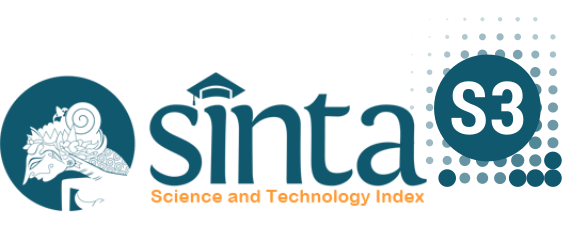Association between high-risk pregnancy and mode of delivery in Kalibaru
DOI:
https://doi.org/10.31101/jhtam.4087Abstract views 551 times
Keywords:
High-risk Pregnancy, Mode of Delivery, Cesarean Section, Maternal Factors, Maternal SafetyAbstract
Downloads
References
ACOG. 2019. “Vaginal Birth after Cesarean Delivery.” acog.org (205): 415–24. doi:10.1002/9781119636540.ch47.
Arendt, Neha Esther, Singh, Oona, and Campbell. 2018. “‘Effect of Maternal Height on Caesarean Section and Neonatal Mortality Rates in Sub-Saharan
Africa: An Analysis of 34 National Datasets.’” PLoS ONE 13(2): 1–15.
Aziato, Lydia, and Cephas N. Omenyo. 2018. “Initiation of Traditional Birth Attendants and Their Traditional and Spiritual Practices during Pregnancy and Childbirth in Ghana.” BMC Pregnancy and Childbirth 18(1): 1–10. doi:10.1186/s12884-018-1691-7.
Bergholt, Thomas, Finn E. Skjeldestad, Aura Pyykönen, Steen C. Rasmussen, Anna Maija Tapper, Ragnheiður I. Bjarnadóttir, Alexander Smárason, et al. 2020. “Maternal Age and Risk of Cesarean Section in Women with Induced Labor at Term—A Nordic Register-Based Study.” Acta Obstetricia et Gynecologica Scandinavica 99(2): 283–89. doi:10.1111/aogs.13743.
Bi, Shilei, Lizi Zhang, Jingsi Chen, Minshan Huang, Lijun Huang, Shanshan Zeng, Yulian Li, et al. 2021. “Maternal Age at First Cesarean Delivery Related to Adverse Pregnancy Outcomes in a Second Cesarean Delivery: A Multicenter, Historical, Cross-Sectional Cohort Study.” BMC pregnancy and childbirth 21(1): 126. doi:10.1186/s12884-021-03608-9.
Braggion, Axelle, Guillaume Favre, Karine Lepigeon, Joanna Sichitiu, David Baud, and David Desseauve. 2023. “Advanced Maternal Age Among Nulliparous at Term and Risk of Unscheduled Cesarean Delivery.” American Journal of Obstetrics and Gynecology MFM 5(8): 100972. doi:10.1016/j.ajogmf.2023.100972.
Chen, Xiaoxu, Jinsong Gao, Juntao Liu, Jing Hu, Sijian Li, Yabin Tang, Mei Zhong, et al. 2021. “Previous Mode of Delivery Affects Subsequent Pregnancy Outcomes: A Chinese Birth Register Study.” Annals of Translational Medicine 9(14): 1135–1135. doi:10.21037/atm-20-8127.
Hidayati, DrNsRatna, Devin Setyorini, and Nian Afrian Nuari. 2018. “Differences Complications During Perinatal in History of Women With Diabetes Mellitus and Obesity Gestational.” 9(2): 148–60.
Irwinda, Rima, Rabbania, Hiksas, Angga, Wiratama, Lokeswara, and Wibowo. 2021. “‘Maternal and Fetal Characteristics to Predict C-Section Delivery: A Scoring System for Pregnant Women.’” In Women’s Health,.
Landon, Mark B. 2024. “Vaginal Birth after Cesarean Delivery.” Queenan’s Management of High-Risk Pregnancy: An Evidence-Based Approach: 415–24. doi:10.1002/9781119636540.ch47.
Marbaniang, Strong, Hemkhothang, Lhungdim, Himanshu, and Chaurasia. 2022. “‘Effect of Maternal Height on the Risk of Caesarean Section in Singleton Births: Evidence from a Large-Scale Survey in India.’” BMJ Open 12(1): 1–9.
Marsay, Carina, Lenore Manderson, and Ugasvaree Subramaney. 2017. “Validation of the Whooley Questions for Antenatal Depression and Anxiety among Low-Income Women in Urban South Africa.” South African Journal of Psychiatry 23(1). doi:10.4102/sajpsychiatry.v23i0.1013.
Muñoz-Saá, Laura E., Rebeca Sendra, Isabel Carriles, Mafalda Sousa, Miriam Turiel, Álvaro Ruiz-Zambrana, and Luis Chiva. 2024. “Maternal and Fetal Outcomes after Multiple Cesarean Deliveries.” Journal of Clinical Medicine 13(15). doi:10.3390/jcm13154425.
Nedberg, Ingvild Hersoug, Charlotta Rylander, Finn Egil Skjeldestad, Ellen Blix, Tamar Ugulava, and Erik Eik Anda. 2020. “Factors Associated with Cesarean Section among Primiparous Women in Georgia: A Registry-Based Study.” Journal of Epidemiology and Global Health 10(4): 337–47. doi:10.2991/jegh.k.200813.001.
Patamasingh Na Ayudhaya, Orada, Wanitchaya Kittikraisak, Podjanee Phadungkiatwatana, Danielle Rentz Hunt, Krissada Tomyabatra, Tawee Chotpitayasunondh, Romeo R. Galang, et al. 2024. “Evaluation of Cesarean Delivery Rates and Factors Associated with Cesarean Delivery among Women Enrolled in a Pregnancy Cohort Study at Two Tertiary Hospitals in Thailand.” BMC Pregnancy and Childbirth 24(1): 1–13. doi:10.1186/s12884-024-06314-4.
Pavlidou, Eleni, Georgios Antasouras, Sousana K. Papadopoulou, Olga Alexatou, Dimitrios Papandreou, Maria Mentzelou, Gerasimos Tsourouflis, et al. 2023. “Association of Maternal Risk Factors with the Prevalence of Caesarean Section Deliveries: A Cross-Sectional Study.” Medical sciences (Basel, Switzerland) 11(4): 1–15. doi:10.3390/medsci11040066.
Phommachanh, Sysavanh, Dirk R. Essink, Maaike Jansen, Jacqueline E.W. Broerse, Pamela Wright, and Mayfong Mayxay. 2019. “Improvement of Quality of Antenatal Care (ANC) Service Provision at the Public Health Facilities in Lao PDR: Perspective and Experiences of Supply and Demand Sides.” BMC Pregnancy and Childbirth 19(1): 1–14. doi:10.1186/s12884-019-2345-0.
Rady, Helmy A. 2018. “Cesarean Section Rate and Indications in Primigravida in EL Shatby Hospital, Alexandria, Egypt.” Journal of South Asian Federation of Obstetrics and Gynaecology 10(4): 381–83. doi:10.5005/jp-journals-10006-1630.
Rydahl, Eva, Eugene, Declercq, Mette, Juhl, Rikke, Damkjær, and Maimburg. 2019. “Cesarean Section on a Rise—Does Advanced Maternal Age Explain the Increase? A Population Register-Based Study.”
Sarina, Mirriam Mkhize, Jaydon Farao, Londiwe Deborah, Shandu, Livhuwani, Muthelo, and Lauren. 2023. “Digital Health Technologies for Maternal and Child Health in Africa and Other Low- and Middle-Income Countries: Cross-Disciplinary Scoping Review With Stakeholder Consultation.” Journal of Medical Internet Research 25(1): e42161.
Sethi, Vani, Arti Bhanot, Sourav Bhattacharjee, Rajkumar Gope, Debjeet Sarangi, Vikash Nath, Nirmala Nair, et al. 2019. “Integrated Multisectoral Strategy to Improve Girls’ and Women’s Nutrition before Conception, during Pregnancy and after Birth in India (Swabhimaan): Protocol for a Prospective, Non-Randomised Controlled Evaluation.” BMJ Open 9(11): 1–9. doi:10.1136/bmjopen-2019-031632.
Sinaga, Asnita. 2022. “The Effect of Primigravida Mother’s Perineal Massage on Perineal Rupture in Tutun Sehati Pratama Clinic, Tanjung Morawa District Deli Serdang Year 2021.” Science Midwifery 10(4): 3348–51. doi:10.35335/midwifery.v10i4.811.
Sun, Guoqiang, Ying Lin, Honglian Lu, Wenjing He, Ruyan Li, Lijun Yang, Xian Liu, et al. 2020. “Trends in Cesarean Delivery Rates in Primipara and the Associated Factors.” BMC Pregnancy and Childbirth 20(1): 1–9. doi:10.1186/s12884-020-03398-6.
Thornton, Jennifer M., Brendan Browne, and Meenakshi Ramphul. 2020. “Mechanisms and Management of Normal Labour.” Obstetrics, Gynaecology and Reproductive Medicine 30(3): 84–90. doi:10.1016/j.ogrm.2019.12.002.
Woollett, Nataly, Monica Bandeira, Sibusiswe Marunda, Lynette Mudekunye, and Liesel Ebersohn. 2021. “Adolescent Pregnancy and Young Motherhood in Rural Zimbabwe: Findings from a Baseline Study.” Health and Social Care in the Community 29(6): e377–86. doi:10.1111/hsc.13362.
Downloads
Published
How to Cite
Issue
Section
License
Copyright (c) 2025 WIWIT ASLINA, Silviatul Amalia, Nita Indah Lestari

This work is licensed under a Creative Commons Attribution-ShareAlike 4.0 International License.
Authors who publish with Journal of Health Technology Assessment in Midwifery agree to the following terms:
- Authors retain copyright and grant the journal right of first publication with the work simultaneously licensed under a Creative Commons Attribution License (CC BY-SA 4.0) that allows others to share the work with an acknowledgment of the work's authorship and initial publication in this journal.
- Authors are able to enter into separate, additional contractual arrangements for the non-exclusive distribution of the journal's published version of the work (e.g., post it to an institutional repository or publish it in a book), with an acknowledgment of its initial publication in this journal.
- Authors are permitted and encouraged to post their work online (e.g., in institutional repositories or on their website) prior to and during the submission process, as it can lead to productive exchanges, as well as earlier and greater citation of published work.

Journal of Health Technology Assessment in Midwifery is licensed under a Creative Commons Attribution-ShareAlike 4.0 International License..













